Tanzania’s Flags
When we think of a nation’s history, particularly an African nation’s, we often think of it as a “before and after” image: on the left hand side is the pre-independence colony or territory, on the right, the country we know today.
But (of course) history is rarely as clean-cut as a split-screen, even in the most peaceful countries. One interesting way to track a country’s changing face is through its changing flags; each successive government’s stamp can be seen in these historical relics, every one a symbol of its era.
Though Arabian, Indian, and Asian traders had been traveling to the East African coast for years, it wasn’t until 1505 that a European power started waving a flag over any part of modern-day Tanzania. In that year, the Portuguese claimed the island of Zanzibar; they would control the island until the end of the 17th century.
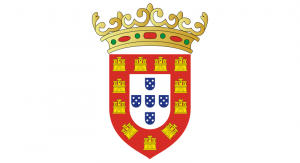
The Portuguese flag has itself changed multiple times, but at the time of Portugal’s conquest of Zanzibar, the King Manuel I coat of arms was in use.
Photo: Wikipedia
By the end of the 17th century, Arab slavers from Oman (who were well established in Zanzibar, then the seat of the Arab slave trade) were gaining more and more influence in the region, until they managed to successfully overthrow the Portuguese in 1698. At that time, the Sultanate’s flag was a simple red rectangle, which flew over Zanzibar for well over a century. In the mid-19th century, however, Zanzibar was made an independent sultanate, with its own (far more interesting) flag.
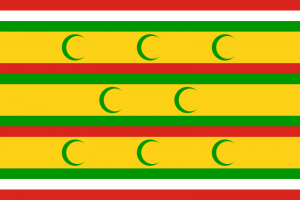
After flying a plain red Omani flag for over a century, Oman established the independent Sultanate of Zanzibar in 1856.
Photo: Wikipedia
Life in East Africa stayed much the same throughout the 18th and 19th centuries, with a few Swahili cities on the coast involved in trade, while the interior remained largely unexplored.
That is until the “Scramble for Africa.”
Though European explorers had been mapping Africa for decades, and most countries had some territories near the coasts, by the late 19th century, only about 10% of Africa was controlled by European territories. After the Scramble—which started around 1880 and ended with the start of World War I—Ethiopia and Liberia were the only African nations that hadn’t been claimed.
The Berlin Conference of 1885 laid out rules for how the various colonial powers would distribute Africa’s lands amongst themselves, and in 1886, Britain and Germany divided up East Africa. Tanganyika (as the country, minus Omani-controlled Zanzibar, was known at the time) went to Germany; Britain took many of the lands to the north, including Kenya.
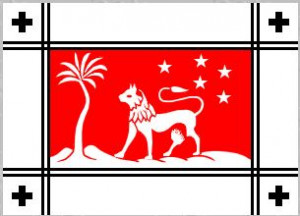
The flag of the German East Africa company in 1885
FOTW Flags Of The World website at https://flagspot.net/flags
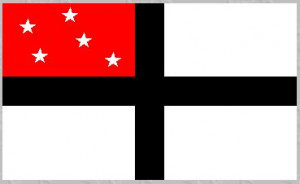
The German East Africa flag after 1895
FOTW Flags Of The World website at https://flagspot.net/flags
But World War I changed landscapes far beyond Euro
pe; the same battles playing out all over Europe were being fought in the colonies, and after the fighting was over, the victors took worldwide spoils, including Tanganyika (unsurprisingly, the Brits opted not to continue referring to the country as “German East Africa”).
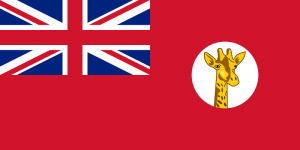
Like many British Colonial flags at the time, Tanganyika’s featured the Union Jack plus a little “local color.”
Photo: Wikipedia
From 1919-1961, the British acted as colonial rulers of Tanganyika (by this time, they’d been the power behind Zanzibar for some time, too). Then something truly shocking happened. After years of organizing by the Tanganyikan people, the British agreed to a peaceful transition to independence.
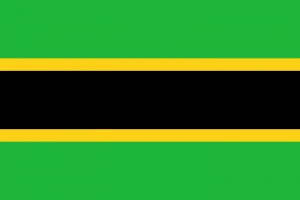
The Republic of Tanganyika (originally the Commonwealth Realm of Tanganyika) lasted from independence, in 1961, through 1964, when the nation joined with Zanzibar.
Photo: Wikipedia
Zanzibar wasn’t considered part of Tanganyika at the time, and remained under British control until 1963. In 1964, the island republic merged with Tanganyika, forming a unified state…and name: Tan-Zan-ia
 The Tanzanian flag as we know it today, first flown in 1964
The Tanzanian flag as we know it today, first flown in 1964
Photo: Wikipedia
But there’s a postscript to this story. Zanzibar had historically always been separate from Tanganyika, and their merger didn’t eradicate the Zanzibari sense of a separate identity. Accordingly, Zanzibar adopted yet another flag in 2005: a mixture of a flag from the brief window between Zanzibari independence and its merger with Tanganyika and the current Tanzanian flag.
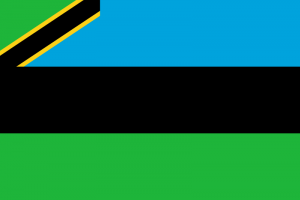
This flag has waved over Zanzibar since 2005
Photo: Wikipedia

